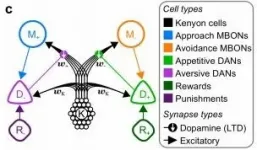(Press-News.org) Children ages two to five who have the most common form of cystic fibrosis (CF), caused by two copies of the F508 gene mutation, have not had any modulator treatments available to them until recently. A new study authored by researchers at Children's Hospital Colorado and published May 6, 2021, in Lancet Respiratory Medicine shows that the CFTR modulator - lumacaftor/ivacaftor - can be safe and well-tolerated for this age range for up to 120 weeks, allowing younger children to begin proactive treatment of CF earlier in their lives.
CF affects more than 70,000 people worldwide and is a chronic, progressive, life-shortening genetic disease caused by an absent or defective protein called the CF transmembrane conductance regulator (CFTR) protein, resulting from mutations in both copies of the CFTR gene. Most people with CF have little to no CFTR protein function. CFTR modulators target the specific defects caused by mutations in the CFTR gene to increase the quantity or function of CFTR protein. Lumacaftor/ivacaftor is the first combination CFTR modulator therapy approved to treat people with CF who have two copies of the most common disease-causing CFTR mutation.
While a prior study found that up to 24 weeks of lumacaftor/ivacaftor was safe and effective, the safety and efficacy of long-term lumacaftor/ivacaftor treatment had not previously been investigated in children under the age of six. During this new study, 57 children between two and five years of age received weight- and age-based doses of lumacaftor/ivacaftor every 12 hours for over 96 weeks with the end results demonstrating that lumacaftor/ivacaftor is safe, effective and can be used for up to 120 weeks of treatment.
"Starting CFTR modulator treatments at a younger age may help to slow and hopefully prevent some of the devastating consequences of CF, such as lung damage, lung function decline and frequent illnesses or hospitalizations," said lead study author Jordana Hoppe, MD, a pediatric pulmonologist with Children's Hospital Colorado and assistant professor of pediatrics at the University of Colorado School of Medicine on the Anschutz Medical Campus. "Prior to the approval of lumacaftor/ivacaftor for children between 2-5 years old, younger patients with two copies of the F508 mutation could only receive symptomatic treatments such as manual chest percussion to clear mucus from the airways, nebulized treatments or antibiotics. The modulator therapy is preventive instead of reactive, targeting the function of the protein to make it work better."
Another key finding demonstrated improvements or an increase in pancreatic function. CF can cause pancreatic insufficiency so that those with the disease must ingest pancreatic enzymes every time they eat to maintain growth and nutrition. These results suggest that for some patients treated with the CFTR modulator therapy, there may be improvement in pancreatic function, possibly resulting in changes to their enzyme dosing.
Additional results included changes in sweat chloride, improved weight gain and growth, and increased lung clearance. It also helps prevent pulmonary exacerbations or respiratory illnesses that require hospitalizations and antibiotic therapy, which has been especially alleviating for families during the COVID-19 pandemic.
"These patients will be transitioned to a more highly effective modulator TRIKAFTA*, but there are certainly benefits to starting modulator therapy at a younger age as the results of this study demonstrated," Hoppe said.
Study visits were conducted in the Colorado Clinical and Translational Sciences Institute (CCTSI) research area at Children's Hospital Colorado. The hospital's Mike McMorris Cystic Fibrosis Research and Care Center is the largest center of its kind in the nation and follows close to 400 children.
"The Colorado Clinical and Translational Sciences Institute (CCTSI) has been a longtime partner with the Mike McMorris Cystic Fibrosis Research and Care Center. Our pediatric Clinical and Translational Research Center and our specialized research nursing staff assist the CF investigators like Dr. Hoppe with conducting CF clinical trials in many ways, including collecting data and obtaining specimens, infusing medications and educating the families and children about research," said Ronald Sokol, MD, director of the CCTSI and vice chair of pediatrics at Children's Hospital Colorado.
*In 2019, researchers at the Children's Hospital Colorado Breathing Institute, one of the largest CF clinical care centers in the U.S., were part of a Therapeutics Development Network that oversaw clinical trials leading to FDA approval of TRIKAFTA, a highly effective CF treatment for people with CF 12 years of age and older. The team was also involved in trials of TRIKAFTA in children ages 6-11 years, which was recently proven efficacious for this patient population and could be soon approved by the FDA for use for kids 6 and older. TRIKAFTA is a combination of three medicines that can improve the CFTR protein function to over 50%, helping approximately 90% of people living with CF.
INFORMATION:
ABOUT CHILDREN'S HOSPITAL COLORADO
Children's Hospital Colorado is one of the nation's leading and most expansive pediatric healthcare systems with a mission to improve the health of children through patient care, education, research and advocacy. Founded in 1908 and recognized as a top ten children's hospital by U.S. News & World Report, Children's Colorado has established itself as a pioneer in the discovery of innovative and groundbreaking treatments that are shaping the future of pediatric healthcare worldwide. Children's Colorado offers a full spectrum of family-centered care at its urgent, emergency and specialty care locations throughout Colorado, including its location on the Anschutz Medical Campus, and across the region. In 2019, Children's Hospital Colorado, Colorado Springs, opened as the first pediatric-only hospital in southern Colorado. For more information, visit http://www.childrenscolorado.org, or connect with us on Facebook and Twitter.
Despite their extremely small size, submicron atmospheric aerosols are critical pollutants with climate change, air quality, and human health implications. Of these particles, secondary organic aerosols (SOA) form when volatile organic compounds (VOCs) oxidize to lower volatility products that bond with and increase aerosol particle size, or in some cases, they may simply exist by themselves. SOA constitutes a significant fraction of the global aerosol mass. Scientists are attempting to improve future aerosol modeling, but several discrepancies still exist between model-simulated and field-observed SOA budgets.
''Large uncertainties in model assessments of SOA budgets and correspondingly, its climate effects, ...
Nanofabrication of electronic devices has reached a single nanometer scale (10-9 m). The rapid advancement of nanoscience and nanotechnology now requires atomic-scale optical spectroscopy in order to characterize atomistic structures that will affect the properties and functions of the electronic devices.
The international team headed by Takashi Kumagai at Institute for Molecular Science discovered a huge enhancement of Raman scattering mediated by a formation of an atomic point contact between a plasmonic silver tip and a Si(111)-7×7 reconstructed surface. This was achieved by means of state-of-the-art low-temperature tip-enhanced ...
Anesthestic drugs act on the brain but most anesthesiologists rely on heart rate, respiratory rate, and movement to infer whether surgery patients remain unconscious to the desired degree. In a new study, a research team based at MIT and Massachusetts General Hospital shows that a straightforward artificial intelligence approach, attuned to the kind of anesthetic being used, can yield algorithms that assess unconsciousness in patients based on brain activity with high accuracy and reliability.
"One of the things that is foremost in the minds of anesthesiologists is 'Do I have somebody who is lying in front of me who may be conscious and I don't realize it?' Being ...
Even the humble fruit fly craves a dose of the happy hormone, according to a new study from the University of Sussex which shows how they may use dopamine to learn in a similar manner to humans.
Informatics experts at the University of Sussex have developed a new computational model that demonstrates a long sought after link between insect and mammalian learning, as detailed in a new paper published today in Nature Communications.
Incorporating anatomical and functional data from recent experiments, Dr James Bennett and colleagues modelled how the anatomy and physiology of the fruit fly's brain can support learning according to the reward prediction error (RPE) hypothesis.
The computational model indicates how dopamine neurons in an area of ...
PITTSBURGH, May 7, 2021 - In a paper published today in Nature Communications, an international group of collaborators led by researchers at UPMC Children's Hospital of Pittsburgh have identified a genetic cause of a rare neurological disorder marked by developmental delay and loss of coordination, or ataxia.
The disorder, scientists found, is caused by mutations in a protein called GEMIN5--one of the key building blocks of a protein complex that controls RNA metabolism in neurons. No mutations in GEMIN5 were previously linked to any genetic disease. ...
Luxembourg, 7 May 2021 - In a new position statement, Alzheimer Europe has issued a call for prioritisation of people with dementia and their carers in national COVID-19 vaccination strategies, urging governments to recognise the disproportionate effect of the pandemic on these groups.
Alzheimer Europe has today issued a call for people with dementia and their carers to be given priority in the ongoing COVID-19 vaccination campaigns across Europe.
In its position statement, Alzheimer Europe notes that people with dementia have almost twice the risk for developing COVID-19 compared to their ...
Systemic inequalities mean that low-income households in London are more likely to be exposed to higher levels of indoor air pollution, according to a report by UCL researchers.
The biggest factors are the quality of housing and the characteristics of the surrounding environment, taking location and levels of outdoor air pollution into account - factors beyond occupants' control.
Air pollution exposure is the greatest environmental health threat in the UK, with long-term exposures estimated to cause 28,000-36,000 premature deaths a year.
In the paper, published in Buildings and Cities, researchers used available data and models, assembling evidence to examine five factors explaining why lower socio-economic groups may be exposed to higher levels of indoor air pollution ...
LUGANO, 7 May, 2021- Findings presented at today's EADV 2021 Spring Symposium suggest that an imbalance in gut microbiota (dysbiosis), could play a significant role in the progression of inflammatory skin disease, Hidradenitis Suppurativa (HS). HS is a painful, long-term skin condition, with a chronic and relapsing nature that significantly impacts patients' quality of life.
Researchers at Hacettepe University collected faecal samples from 15 patients with HS and 15 age and sex matched healthy individuals and analysed regions of the bacterial 16S rRNA gene to investigate ...
LUGANO, 6 May, 2021- The dermatological impact of COVID-19 is a burning topic at EADV's 2021 Spring Symposium. New research presented today highlights the effect that stringent hand hygiene during the pandemic has had on hand skin health.1
Researchers at Father Muller Medical College, India, analysed transepidermal water loss (TEWL - an essential parameter for measuring skin barrier function) from 582 people (291 healthcare professionals (HCPs) and 291 healthy individuals from the general population). Results indicated that hand dermatitis was now present among 92.6% of HCPs and 68.7% of the general population, despite only ~3% of HCPs and 2.4% of the general public in the study having reported a prior history of hand dermatitis (obtained through medical history ...
Are penalty shots a soccer player's dream or nightmare? What should be an easy shot can become a mammoth task when the hopes and fears of an entire nation rest on a player's shoulders, leading them to choke under pressure. Understanding the brain activity behind choking is the driving force behind a new study in open-access journal Frontiers in Computer Science. The study is the first to measure brain activity during penalty shots in a soccer pitch environment. It finds that people who choked activated areas of the brain involved in long-term thinking, suggesting that they were overthinking the consequences of missing the shot. ...






